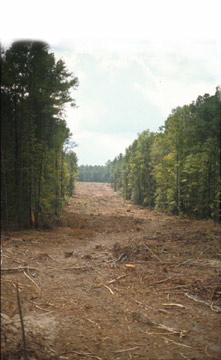 |
downloadable
pdf
An
Ambitious University of Florida-Led Study Favors Wildlife
Corridors
by
Aaron Hoover
A
few years ago, a researcher was examining satellite pictures
of federal forest in South Carolina when she noticed something
odd — Large patches of rectangular clearings arranged
in patterns but unconnected by roads.
Rachel Clement and her colleagues at the U.S. Geological Survey,
who were doing a national survey of land cover change, were
mystified. Because the forest is part of a major Cold War-era
nuclear weapons production site, they let their imaginations
run wild. Were the 40-odd clearings waste disposal sites?
Perhaps UFO landing pads?
“They really gave us a time, figuring out what in the
heck these forest openings were used for,” Clements
recalled.
A few phone calls and a search through scientific literature
revealed that rather than indications of other-worldly visitors,
the clearings were part of a huge experiment on Earth’s
creatures. Headed by the University of Florida, the experiment,
which began in 1999 and continued through last year, was perhaps
the most ambitious attempt ever to answer a question that
has bedeviled biologists for decades. The question —
whether wildlife corridors really help wildlife and plants
— is all the more intriguing because most people outside
the ecology community take the answer for granted.
|
| Doug
Levey, a UF zoology professor and one of the leading investigators
on the corridor study, says finding scientific proof for
the benefits of wildlife corridors has been challenging. |
Flawed
History
Many communities in Florida and elsewhere have set aside undeveloped
land for wildlife corridors, or greenways, linking one natural
area to another. First envisioned as early as the 1960s, these
greenways are touted as ways not only to reduce urban sprawl
but also to allow wildlife and plants spread across natural
landscapes cut into pieces by roads, development or logging.
The idea is that corridors not only allow animals to find
new resources, but also prevent the isolation of species —
isolation that can even lead to extinction if the habitat
fragments are not accessible for reproduction or re-colonization.
Intuitively, corridors make wonderful sense. But finding scientific
support for their apparent benefits has been remarkably tough,
says Doug Levey, a UF professor of zoology and one of the
lead investigators on the UF study.
Previous studies showed that wild areas connected by corridors
have more wildlife or greater biodiversity than disconnected
areas. But these studies often failed to account for other
influences, Levey says. For example, corridors in urban areas
often lie along rivers because these flood-prone areas tend
to go undeveloped. But waterways represent one type of habitat
that may benefit wildlife and plants more than the corridors
themselves, he says. Other studies purporting to show the
benefits of corridors compared rural and more urban areas,
leaving unclear whether the corridors or simply the areas’
remoteness accounted for the observed differences.
Experiments on corridors, meanwhile, are difficult to pull
off because the areas needed to test and repeat them are so
large, at least for the big animals that people like to think
corridors help protect. An experiment exploring whether corridors
benefit black bears, for example, would require an undeveloped
area equal to the bears’ range of hundreds of miles.
And other similarly huge natural areas would be needed to
repeat the experiment to test its conclusions. As a result,
most scientifically rigorous corridor experiments have taken
place on much smaller scales. One noted experiment, for instance,
focused on insects on 20-by-20-square-inch plots of moss,
some isolated and some connected by pencil-thin corridors.
The UF-led team sought to increase that scale, and
then some.
Unique
Laboratory
The researchers mapped out eight similar sites, each about
158 acres, in the Savannah River Site National Environmental
Research Park near the South Carolina-Georgia state line.
The park is a 482-square-mile federally protected research
area set aside early in the Cold War to purify plutonium for
nuclear weapons. When carving it out in the 1940s, government
officials relocated two entire towns and closed off the land
to civilian activity. Because only a small part of the park
served as home to the reactors and research facilities, most
of the land remained undeveloped, gradually returning to its
natural state. The U.S. Forest Service, which now manages
much of the park, allows logging in some areas but has set
aside others for ecological and biological research.
|
|
Researchers
mapped out eight similar sites, each about 158 acres,
in the Savannah River Site National Environmental Research
Park near the South Carolina-Georgia state line. The U.S.
Forest Service arranged for loggers to remove trees and
burn the remaining groundcover, creating one central clearing
and four peripheral clearings on each site. The experiment
included three kinds of clearings;
a) isolated clearings
b) "winged" clearings
c) connected clearings |
Levey
says the ghosts of the site’s top-secret activities
remain. “You can be driving down the road and there’s
a sign that says ‘Starve a spy, feed a shredder.’
And there’s another sign that says, ‘What’s
at the heart of security? UR.’”
Forests of 50-year-old pine trees dominated all eight of the
UF research plots. At the researchers’ request, the
U.S. Forest Service arranged for loggers to remove trees and
burn the remaining groundcover, creating one central clearing
and four peripheral clearings on each site. The loggers also
logged corridors connecting each central clearing to one of
the peripheral clearings, leaving the others separated by
the forests. Each clearing measured about two acres.
Levey says such complicated arrangements probably couldn’t
have happened anywhere else.
“The way that loggers usually operate is they come in
and they clear cut and they build roads into places —
well, if you built a road into our sites you would be creating
a corridor,” he says. “We had to specify that
they could not cut any trees to
get the trees out of the patches they created, which was a
pain for them.”
Carved out in 1999, the clearings quickly grew into fields.
The habitat in these “patches” was radically different
from that of the surrounding woods — plants and
animals found in the patches would never thrive in the woods,
or vice versa. Research on the sites spanned 2000 to 2001.
The team — which included zoologists Nick Haddad of
North Carolina State University, Brent Danielson of Iowa State
University, Sarah Sargent of Allegheny College in Pennsylvania
and numerous graduate students — did two major experiments.
In one, researchers planted male holly bushes in the central
patch and female hollies in the four peripheral patches. They
chose holly because it is not naturally present in the forest
and the females cannot bear fruit unless pollinated by males.
The researchers waited until the hollies flowered and then
measured the fruit set, or the percentage of flowers that
turned into berries, in each of the clearings.
The result: The hollies in the connected patches were consistently
more fruitful than in the unconnected ones. This indicated
that more wasps, butterflies and other insect pollinators
made it from each central patch through the corridor than
through the forest.
When birds or other animals eat fruits, they often distribute
the seeds to new locations in their droppings, an important
way that plants spread. To gauge the effects the corridors
had on this process, the researchers marked thousands of seeds
of wax myrtle and holly in the central patch with a sticky
powder that can be seen only with a florescent light. The
researchers then placed seed traps under 16 bird perches built
in each of the connected and unconnected peripheral patches.
Over several months, they collected and analyzed the resulting
bird droppings in a lab.
Given the grand scale of the experiment, the work was not
without difficulties. For one thing, many of the first hollies
that were planted died because of a drought at the time. As
a result, the researchers had to spend thousands of dollars
on an
extensive irrigation system. And they also had to sort a lot
of bird poop.
“We collected thousands and thousands of defecations
from birds, and it takes a lot of time to go through them
all,” says Josh Tewksbury, a UF postdoctoral researcher
at the time
of the study and now an assistant professor at the University
of Washington.
The resulting data revealed that significantly more droppings
containing wax myrtle and holly seeds were carried from the
central patches to the connected patches than to the unconnected
patches. This indicated that more birds were flying between
the connected patches than the unconnected ones.
“There were almost double the center patch’s droppings
in the connected receiver patches versus the unconnected patches,”
Levey says.
The findings probably go well beyond just pollination and
seed dispersal. When plants have more pollen, they produce
more fruit, attracting more birds, which distribute more seeds,
which attract more birds and seed-eating animals, and so on.
So, although the experiment tested only two processes, it
suggests that corridors can be beneficial in the much larger
biological community.
“Our study suggests that these corridors do help in
connecting populations, and theoretically they should help
sustain networks of populations existing in increasingly fragmented
landscapes,” Tewksbury says
Toward
A More Complete Picture
The scale of the UF experiment was not the only thing that
made it rigorous. Scientists reduced the size of the patches
with corridors to make sure the area of the connected patches
matched the area of the isolated patches. This addressed a
common criticism of previous studies: that the added natural
area that comes with corridors might itself account for their
benefits, as opposed to the corridors themselves.
Another long-standing theory was that the beneficial effects
of corridors are not related to the corridors themselves —
but rather to the so-called “drift net” effect.
This held that birds and animals migrating through an area
are more likely to run into the corridor than smaller unconnected
patches, which would increase their numbers. With this in
mind, the UF team elongated some patches with “wings.”
The resulting data showed no significant differences between
these longer patches and the regular ones.

As complete as it was, the study hardly put an end to the
corridors controversy. Levey says that although the first
experiment demonstrated corridors positively affected pollinators
and seed disbursers — which help plants — it did
not examine whether they could also help seed-eaters and herbivores
— which hurt plants. Grasshoppers, mice and deer might
use corridors to eat more plant seed and plants. “Who
knows? Corridors may benefit those ‘bad guys’
in terms of plant animal interactions more than the ‘good
guys’ — and if they do, then corridors may be
bad news for plants,” Levey says.
The researchers hope to get at that question with a major
follow-up study examining these variables. Although their
initial proposal to the National Science Foundation did not
get funded last summer, they plan to apply again in the fall.
Ultimately, the value of the corridor study, and other studies
like it, may be that they bolster conservationists’
arguments that corridors and greenways are worth preserving.
As Levey says, “The balance of evidence thus far is
certainly that corridors are beneficial.”
Douglas J. Levey
Professor, Department of Zoology
(352) 392-9169
dlevey@zoo.ufl.edu
|



